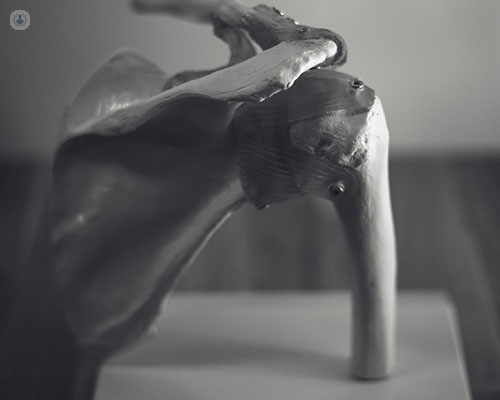Shoulder instability: A quick guide to the causes, diagnosis and treatment
Written in association with:In his latest online article, highly experienced consultant trauma and orthopaedic surgeon Mr Angelos Assiotis delves into shoulder instability. He explains the causes, diagnosis and treatment of this condition.

What causes shoulder instability?
Shoulder instability may be anterior (the humeral head ‘comes out the front’ of the socket), posterior (the humeral head ‘comes out the back’ of the socket) or multidirectional (the humeral head can ‘come out’ from any direction).
The vast majority of cases of shoulder instability are caused by an injury. We called these ‘post-traumatic’. However, sometimes shoulder instability may arise without any significant trauma, either due to a developmental/degenerative alteration to the anatomy (‘structural atraumatic’ type) or due to joint hyperlaxity (‘non-structural atraumatic’). Hyperlaxity shoulder instability is usually associated with hypermobility of other joints. Sometimes, patients are able to voluntarily dislocate their joints and reduce them back in place without any significant difficulty.
What are the symptoms of shoulder instability?
Shoulder instability may present as a true dislocation, or as a subluxation event (when the joint nearly dislocates, but then comes back to the normal position). A dislocation event after an injury presents with significant pain in the shoulder, the inability to move the shoulder in any direction and often, and the sensation of tingling or pins-and-needles in the hand. In contrast, subluxation events may present more subtly, as the sensation of discomfort in the shoulder or as a shoulder that feels ‘loose’, when performing certain movements.
How is shoulder instability diagnosed?
The mainstay in the diagnosis of shoulder instability is through a detailed targeted clinical history and examination. Once shoulder instability is confirmed, investigations may be carried out which aim to detail the extent of the pathology and the appropriate management options. Such investigations may include a simple X-ray, a CT scan or an MRI scan, where a special type of dye is injected into the shoulder and then the MRI scan takes place (this is called an MRI arthrogram).
What are the treatment options for shoulder instability?
Shoulder instability may be treated with or without surgery, depending on its cause and severity. Non-surgical treatment includes physiotherapy which aims to strengthen the muscle groups that maintain the humeral head in the centre of the socket.
Surgical treatment may be divided into open and arthroscopic (keyhole). In general, surgery may deal with the soft tissue problem (by re-attaching the ligaments and cartilage structures that get injured after a dislocation) or aim to insert additional bone to fill out a defect that was caused by the injury.
What is the recovery process like after treatment for shoulder instability?
If shoulder instability is treated with physiotherapy, it takes between 6 weeks and 3 months before significant improvement is felt. If the problem is dealt with surgery, wounds take two weeks to heal and usually, the arm is protected in a sling for six weeks after surgery. Physiotherapy is again crucial, after an operation, and a specific rehabilitation protocol will be given to you by your physiotherapist, who will supervise your recovery. Return to driving is usually at 6 weeks after surgery and return to sporting activities is usually at three months after the operation (this time interval may be affected by the type of sporting activity pursued by the patient).
Mr Angelos Assiotis is a renowned consultant trauma and orthopaedic surgeon based in London and Hatfield. If you would like to book a consultation with Mr Assiotis, you can do so today via his Top Doctors profile.


